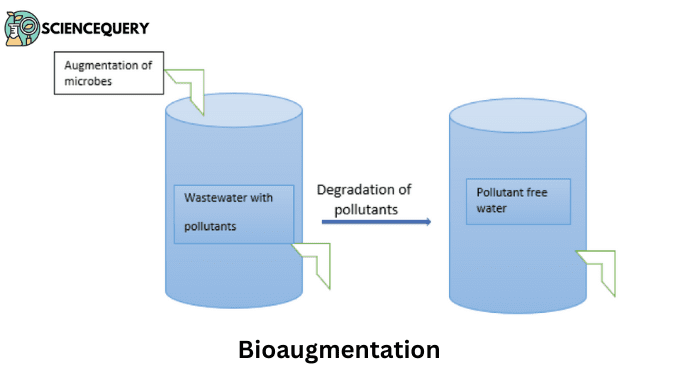
Know in one minute about Bioaugmentation
|
Introduction
Bioaugmentation
Bioaugmentation is a process in which specialized microorganisms are added to perform biodegradation of recalcitrant organic pollutants (present in soil and groundwater). The microbial population is already found in the environment, this technique is designed to enrich this population so that it will help to reduce the contamination level.
How bioaugmentation works
Bioaugmentation increases the active microbes and microorganisms level in the treatment environment. The contaminants are transformed into less harmful substances by these microbes. These microbes act as biocatalysts and degrade the contaminants. Chemical compounds such as acetone, nitrate, acrylic compounds, phenolic compounds, and other industrial waste can be biodegraded by this technique.
Process of bioaugmentation

Cultivation
Cultivated bacteria is used for bioaugmentation to enhance the activity of existing microbial populations with
Isolation
Bacteria or microbes are isolated from the environmental sample such as wastewater sample, compost, or soil.
Growth of isolated bacteria
the isolated bacteria are now grown in a nutrient-rich culture medium.
Selection and drying
Bacteria that have the ability to manage large concentrations of target chemicals are selected. The selected bacteria are cultured in large fermenters. The fermented bacteria are then dried for preservation.
Augmentation
Cultured and dried microorganisms are added to perform biodegradation of organic pollutants such as acetone, nitrate, acrylic compounds, phenolic compounds, and other industrial waste.
Application of bioaugmentation
-
Treatment of chlorinated solvent
Chlorinated substances such as tetrachloroethylene and trichloroethylene are the major contaminants of soil and water. Cultured microbes can convert these toxic contaminants into non-toxic ethylene and chloride.
-
Cyanide degradation
During coal processing cyanide is released from the coal, which is the most toxic compound, thus it is important to treat the industrial waste before it is discharged into the environment. Bioaugmentation is used to degrade the cyanide by using cyanide-degrading microbes such as yeast (Cryptococcus humicolus ).
-
Synthetic dye removal
Wastewater from textile and cosmetics industries contains synthetic dyes (azo-and anthraquinone-based molecules) as major contaminants. These contaminants can be removed by this technique.
-
Nicotine degradation
The waste from the tobacco industry contains nicotine which is a toxic substance and a carcinogen, thus is important to degrade the contaminated wastewater before being discharged into the environment. These pollutants are removed by bioaugmentation in which nicotine-degrading bacteria such as Acinetobacter sp. are used.
Difference between biostimulation and bioaugmentation.
| Biostimulation | Bioaugmentation. |
| It is the process to modify the environment by the addition of nutrients, electron donors, and acceptors that stimulate the activity of existing microorganisms. | Is a process in which specialized microorganisms are added to perform biodegradation |
| Mainly used indigenous microorganisms | It mainly used exogenous microorganisms |
| Nutrients and electron acceptors are added | Cultured microorganisms are added |
Bioaugmentation examples
| Pollutants/contaminants | Bioaugmented bacteria | Apparatus/setup |
| Cyanide | Cryptococcus humicolus,
Unidentified cyanide-degrading microorganisms |
Fluidized bed-type process |
| Nicotine | Acinetobacter sp. | Cylindrical reactors |
| Acid orange 7 dye | Shewanella sp. | Membrane aerated biofilm reactor |
| Quinoline | Bacillus sp. | Sequential batch reactor |
| Phenol | Phenol-degrading bacterial mixture | Biological contact oxidation reactor |
Q&A
1. What is an example of bioaugmentation?
Cyanide degradation. Cyanide is released from coal and is the most toxic compound, thus it is important to treat industrial waste before it is discharged into the environment. Bioaugmentation is used to degrade the cyanide by using cyanide-degrading microbes such as yeast (Cryptococcus humicolus ).
2. What is bioaugmentation?
It is a process in which specialized microorganisms are added to perform biodegradation of recalcitrant organic pollutants (present in soil and groundwater).
3. What are the examples of bioaugmentation treatment?
The examples are given below
- Treatment of chlorinated solvent- chlorinated substances such as tetrachloroethylene and trichloroethylene are the major contaminants of soil and water. Cultured microbes can convert these toxic contaminants into non-toxic ethylene and chloride.
- Nicotine treatment- nicotine is a toxic substance and a carcinogen thus is important to degrade the contaminated wastewater before discharging it into the environment. These pollutants are removed by bioaugmentation in which nicotine-degrading bacteria such as Acinetobacter sp. are used
- Cyanide degradation-. Bioaugmentation is used to degrade the cyanide by using cyanide-degrading microbes such as yeast (Cryptococcus humicolus)
4. Are fungal pure cultures approved in in-situ bioaugmentation?
The fungal pure cultures can be used in situ bioaugmentation for the treatment of heavy metal contaminants.
5. Are genetically modified organisms used in in-situ bioaugmentation?
Yes, genetically modified organisms are used for this method. In this, there is the introduction of plasmid that encodes for the degradation of target contaminants and stimulates the enhancement of the contaminant degradation potential.
References
https://link.springer.com/book/10.1007/978-3-642-19769-7
Written By: Neetu Ladiya
